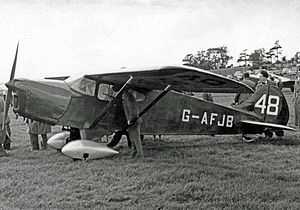Foster Wikner Wicko
| Wicko / Warferry | |
|---|---|
 | |
| Wicko wearing racing No.48 at Wolverhampton's Pendeford Aerodrome in 1953 | |
| Role | Cabin Monoplane |
| Manufacturer | Foster Wikner Aircraft |
| Designer | Geoffrey N Wikner |
| First flight | 1936 |
| Primary user | Royal Air Force |
| Number built | 10 |
| Unit cost |
£650 |
The Foster Wikner Wicko was a 1930s British two-seat cabin monoplane built by the Foster Wikner Aircraft Company Limited at Southampton Airport, Hampshire.
History
Geoffrey Wikner was an Australian aircraft designer who moved to England in May 1934 and with his partners formed the Foster Wikner Aircraft Company Limited to build a low-cost two-seat high-wing monoplane. Low cost was helped by fitting a standard Ford V8 vehicle engine instead of a specialist aero-engine. The V.8 was fitted with a Pobjoy reduction gear and was known as the Wicko F power unit. The prototype aircraft was built at the J.F. Lusty's furniture factory at Bromley-by-Bow. The completed aircraft, designated the Wicko F.W.1 was taken by road to Stapleford Aerodrome, Essex and first flew in September 1936. Due to the 450 lb (200 kg) weight of the engine, the aircraft needed a long takeoff run and had a poor rate of climb.
The prototype was rebuilt as the Wicko F.W.2 with a more powerful but much lighter - 227 lb (103 kg) - aircooled Cirrus Minor I engine. This resulted in a useful reduction in overall weight but the price increased from £425 to £650. The second and subsequent aircraft were built at Southampton Airport after the company moved in 1937. The second machine was initially powered by a Cirrus Major motor and designated F.W.3, but later re-engined with a de Havilland Gipsy Major. The eight machines subsequently completed used this engine as reflected by the name Wicko G.M.1. At the start of the Second World War production ceased and one airframe remained unfinished.
One aircraft exported to New Zealand was impressed into wartime service with the Royal New Zealand Air Force, crashing in 1942. Seven aircraft in the United Kingdom were impressed and another accepted directly into wartime service with the Royal Air Force, under the service name Warferry.
The celebrated woman aviator and ATA veteran Lettice Curtis bought a Wicko after WW2, in which she competed in several Daily Express Air Races.
One aircraft first registered as G-AFJB in 1938 is still operational with a permit to fly (as of 2008). It is one of only two RAF machines to survive the war and has also recovered from a post-landing 80 ft (24 m) fall from a cliff.
Variants
- Wicko F.W.1
- prototype with an 85 hp Wicko F modified Ford V8 engine
- Wicko F.W.2
- prototype re-engined with a 90 hp Blackburn Cirrus Minor I
- Wicko F.W.3
- fitted with a 150 hp Blackburn Cirrus Major engine
- Wicko G.M.1
- production version with a 130 hp de Havilland Gipsy Major engine
- Warferry
- Wicko G.M.1. in RAF service
Operators
Specifications (Wicko G.M.1)
Data from Jackson p. 207
General characteristics
- Crew: 2
- Length: 23 ft 3 in (7.09 m)
- Wingspan: 31 ft 6 in[1] (9.60 m)
- Height: 6 ft 7 in (2.01 m)
- Wing area: 153 ft² (14.21 m²)
- Empty weight: 1,255 lb (569 kg)
- Loaded weight: 2000 lb (908 kg)
- Max. takeoff weight: 2,000 lb (907 kg)
- Powerplant: 1 × de Havilland Gipsy Major 4-cylinder inverted inline piston, 130 hp (97 kW)
Performance
- Maximum speed: 140 mph (225 km/h)
- Cruise speed: 120 mph (192 km/h)
- Range: 480 miles (770 km)
- Service ceiling: 20,000 ft (6,100 m)
- Rate of climb: 800 ft/min (4.06 m/s)
- Wing loading: 13 lb/ft2 (63.4 kg/m2)
- Power/mass: 0.065 hp/lb (10.6 W/kg)
See also
- Related lists
- List of aircraft of the RAF
- List of aircraft of the RNZAF
References
| Wikimedia Commons has media related to Foster Wikner Aircraft. |
- Notes
- ↑ Jane's All the World's Aircraft 1938, p.78c
- Bibliography
- The Illustrated Encyclopedia of Aircraft (Part Work 1982-1985). Orbis Publishing.
- Jackson, A.J. (1974). British Civil Aircraft since 1919 Volume 2. London: Putnam. ISBN 0-370-10010-7.
- Grey, C.G. and Bridgman, L. Jane's All the World's Aircraft 1938. (1972). Newton Abbot: David & Charles. ISBN 0-7153-5734-4
External links
| ||||||||||||||||||||||